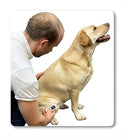Cervical Rotation
Title: Accordance and practicability of the new medical device EasyAngle in comparison to the current gold standard CROM and the iPhone App Compass for measuring the cervical spine rotation in healthy participants
Authors: Sebastian Köcker, Universitätsklinikum Freiburg (2017)
Link to study: here
Number of Subjects: 67 physiotherapy students
Abstract
The development of physiotherapy into a more academic profession requires the development of tools that enable standardized measurements. Today objective measurement especially on the cervical spine still is difficult in clinical practice. Adequate measuring devices for range of motion measurements are available to only a tiny fraction of physiotherapists and the current established devices on the market are impractical for the clocked workflow in a physiotherapy clinic. The EasyAngle device, which has just appeared on the market, looks like a highly promising solution. However, unlike the CROM device which is the current gold standard or an iPhone app that are used to assess cervical rotation, there are no published data yet for this measuring device. Therefore, the purpose of this study is to create an initial dataset of measurements to enable comparison of the EasyAngle device with those that are established on the market.
Methods
67 physiotherapy students participated in the study. All the measurements were taken according to a standardised measurement protocol and they were carried out on the same person. To compare the devices the standard deviation was calculated for measurements with all devices. The participants were randomised into three groups. The first group made measurements with all three devices. The results were evaluated in Bland-Altman plots, using the CROM device as reference. The second and third group used either the EasyAngle or the iPhone app. The results of these groups were used to determine the standard deviation of each measuring device. The practicality of the three devices was evaluated by the participants using an assessment form.
Results
For the EasyAngle device, the study showed a standard deviation of 3.3° compared to 9.9° for the iPhone and 3.8° for the CROM device when the cervical spine rotation assessment was performed. The assessment of the Bland-Altman plot shows a very close correlation with measurements done with the CROM device. At a confidence interval of 95%, the measurements fall within the concordance limits of 10-11°. In the practicality evaluation, the EasyAngle was assessed by 82% of the participants as “very practical”.
Conclusion
The study show that for measurement of rotation in the cervical spine in healthy test subjects the new EasyAngle device has a slightly better accuracy than the CROM device, the current gold standard. The study also show that the EasyAngle is the only device that is considered “very practical” for everyday clinical use. Further studies should be done on patients presenting with cervical spine problems.










